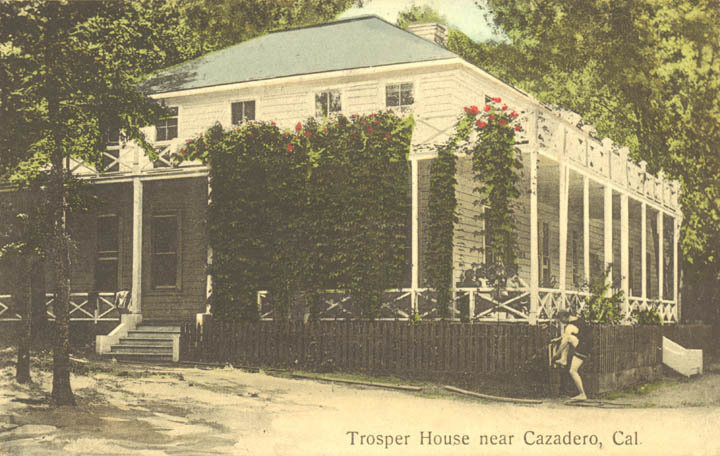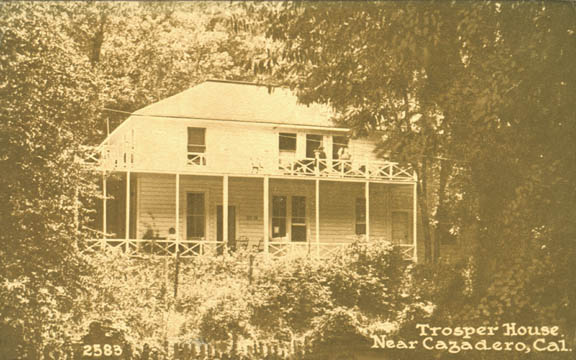

| From Gary Rodgers, the webmaster of The Cazadero, California Website, and Trosper family source: | ||
| ...[the above image] is from a postcard, probably taken circa 1920. Person in photo is a visitor returning from the swimming dam & washing his feet at a water spigot at the corner of the porch. The House structure was begun in 1898 and expansions to the building were finished by 1910. The house was destroyed by fire in the fall of 1936 which started in an auxiliary kitchen wood stove chimney flue." | ||
| Francis Drake Trosper, purchased the property upon which he built his resort in 1898 and the house was completed in 1910. In addition, he later bought a parcel that was later sold by Maruella after Drake died to Gary Rodgers' family. This parcel had once belonged to John William Hopper, who had bought it in 1907. Gary adds this to the history of this particular piece of property: | ||
| ...And then Bill Brown who
owned our parcel in 1914 had amassed a big gambling debt. He tried to sell the
property to William (Bill) Hopper, son of Tom Hopper of Santa Rosa. Bill "By
God" Hopper took up residence on the ranch. Bill was locally known as "By God
Hopper" as he used the expression "By God!" often when talking to people.
Acting on a complaint by the person Brown owed the debt to, Justice of the
Peace Francis Drake Trosper stopped the sale and
removed Hopper from the property. Brown had intended to skip with the money and
Trosper knew this. Drake Trosper then paid the gambling debt of $1800 and took
title to the property. December 31, 1914 Book 329, Page 319. We purchased the
property from Maruella Trosper in 1936. From Cazadero's Charles Chapman memoirs written 1975: Hopper. Willliam 'Bill' Hopp bought the Brown ranch when that family moved to Penngrove. Bill was a son of Tom Hopper of Santa Rosa, a prominent Sonoma County pioneer. People used to call Bill, or William - 'Bill By God Hopper' because he was a little 'banty-sized man' and every other word he uttered was 'by God.' Chapman's father, Rufus, and a man named Sam Break tried to buy Cazadero from George Montgomery once, but shafted Montgomery in the process... [some more details about this is listed in Gary's essay "CAZADERO, CALIFORNIA HISTORY" on his website] ...William Hopper was related to J. W.Hopper in Santa Rosa who had previously owned the Brown ranch from 1907 to 1910 (substantiated by [Sonoma County] Deed Book 267, pages 376-377). |
||
| It is not known to me at this time if
Bill By God Hopper was the son of Thomas Hopper (23 Sep 1820 - 3 Jun 1912),
since I do not have any documentation indicating a William in the family
aside from John William (perhaps Bill could be his
son). However, neither do I have any information on any children for Thomas
Hopper's second marriage. Also, William, was an often used name by this
branch of the Hopper family. In addition, Gary also writes of the Trosper property: |
||
| [Drake] ...needed water for his resort and our property had the nearest full flow spring in the area. Drake in that Hopper/Brown gambling deal took advantage of the law suit to get the spring. Maruella in her diary that was stolen referred to the spring as the "surplus spring." The pipe to the resort is still in place and our deed still has the easement to the resort property in effect... If you'll notice on the plot map the house looks like an 'L'. The L leg or north extension was a large dining room & new kitchen off the original kitchen. When the extension was finished the original smaller kitchen became the "Auxiliary Kitchen" and this is where the fire started. I made a drawing of the house's interior based on the recollections of my dad & grandfather. The cellar on the plot map was an outdoor affair and was dug into the side of the hill. Here canned fruit, wine, etc. was stored. | ||
| From Gary Rodgers: | ||
| In the fall of 1936 a
fire broke out in the Trosper House's auxiliary kitchen wood stove chimney
flue. Seeing the flames Maruella rushed to the
telephone and summoned help. After hearing Maruella's plea and seeing the
smoke, Lee [Menefee] dashed upstairs to
his bedroom to retrieve his money he had stashed under his mattress. Leaving
the room he found himself cut off from the stairwell by a wall of flame so
returned to the bedroom and made his exit through a window onto the second
floor porch deck. He then shinned his way down a support post to safety on the
ground. Johnny Bei, Andrew Bei and Fred Boon were the first men to arrive on
the scene. After surveying the fire's progress, the three men rushed into the
burning building in an attempt to save some possessions. Maruella was safely
outside and having seen Menefee escape the house Maruella told them that there
were no others inside. Once into the smoke filled building Johnny Bei and Boon latched onto the first object they saw, Maruella's large upright piano. They quickly carried it from the burning living room and down the porch stairs to safety. Unable to see clearly in the smoke filled house, Andrew Bei made a hasty retreat and when passing by the bathroom he had a sudden inspiration to save something. He ripped the toilet from the bathroom floor and carried it outdoors and placed it safely on the ground near the piano. The three men were unable to reenter the building and even the fire fighters that had amassed there could do no more than watch the structure burn. The Trosper House was lost to the consuming flames. The next day it took five men to put the piano on a truck and move it across the road to the resort's dance hall. Andrew was given special accolades for his brilliance in saving the toilet. Being without a place to reside, Maruella hired Chester Rodgers to tear down her dance hall and to build a new house from its salvage. It was completed before the winter of 1937 set in, and was located on the eastern side of Austin Creek slightly above the dance hall site. Her new house overlooked her once proud resort. Maruella lived the rest of her life in her new home supported by sales of her land and income from the occasional vacationers of the past that came to stay in her resort's surviving cabins and tents on "Tent Row." Maruella Adams Trosper died on November 2, 1945 and Lee Menefee scattered her ashes in a favorite place of hers a short distance from the resort. They were scattered in a small circular grove of towering redwood trees she called her "Cathedral" as it reminded her of entering into a large church. She often retreated to her Cathedral to sit or lie down amidst the ferns growing by its giant columns for private moments of thought and solitude. |
||

This page created on 04/06/03 21:52. Updated 11/09/03 15:00.